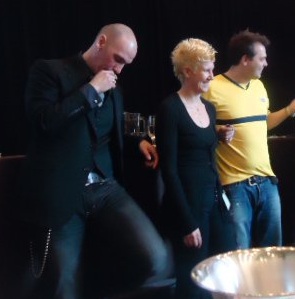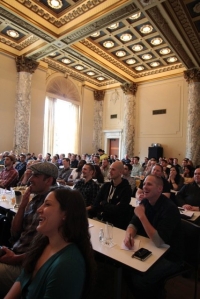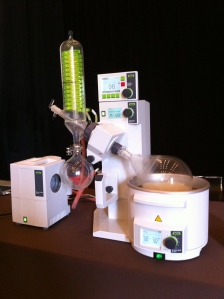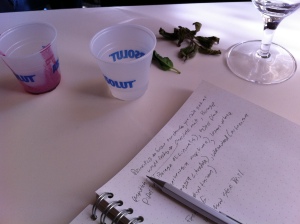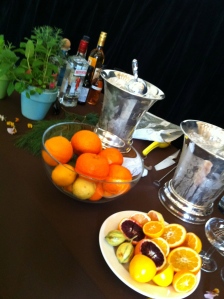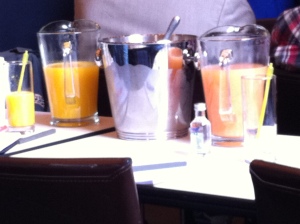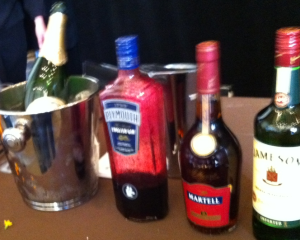Opening my eyes refreshed from a “listening meditation” last night, I sit at the Tibet House (15th St. 5/6) where Dr. Miles Neale, a contemplative psychotherapist, tells about a jarring experience with one of the confrontational types that wander the streets of East Village and how his response to the confrontation created his reality, not the confrontation itself. A quick thought flashes through my mind on the unusual path that led me here, starting, of all places, with a passion for the culture, history and progression of Mixology.
The grand opening of Pernod Ricard’s “Pioneers in Mixology,” whose sessions I’ve described over the past few posts, was helmed by Dushan Zaric and Aisha Sharpe with a workshop entitled, “Mindful Bartending: The Mastery of Service.” It will also be presented as part of the Manhattan Cocktail Classic on May 17 at the Astor Center.
In this fascinating session, Dushan & Aisha mixed Buddhist principles with the realities of bartending life – late hours, near constant contact with alcohol and boundaryless customer expectations in the world of today where everyone with a Facebook, Yelp or other social media account has an audience and increasingly consider themselves a critic – sharing positive secrets only with close friends but warning EVERYONE if something goes awry.
May sound like a daunting lifestyle, but we know it isn’t necessarily, and Dushan freely admits that “this is the coolest job in the world,” made even cooler if you master balance, live mindfully.
He presents the description of a bartender as part Mixologist (master of cocktail history and the expansive and ever-evolving recipe catalog), part Sage (master of ceremonies responsible for operations, atmosphere and attitude of the bar/lounge/resto) and undeniably part Rock Star (larger than life personalities that can & do range a broad spectrum just like real stars. Think about the disparity from Bjork, to D’Angelo, to Flaming Lips, to Ting Tings, to Radiohead to John Mayer).
Dushan himself is ear-ringed, vested, skinny-jeaned & wallet-chained, and Aisha is sporting a blond fem-rock faux-hawkish look with her black teeshirt; neither would look out of place walking off the Bowery Ballroom stage. As I glance around the room at the BarSmarts Mixologists in the 9 a.m. morning light, it is a kick to see these larger-than-life personalities and how they are expressed even before noon – quite a few hipster fedoras & derby hats in the room, hoodies galore, one Nehru jacket, a few more vests and the previously mentioned leopard-print dyed hair – definitely a room of Rock Star personalities.
As the session unfolds, Dushan & Aisha bring to life the “firm your mind, not your butt” brand of yoga. Focusing the room on the importance of a bartender’s mood, which sets the tone for the night (influencing scores of other people), and how their reaction to customer and staff interaction either creates happiness or friction, but every moment the choice is that of the bartender to make. Emphasizing that the ripple effect is as alive behind the bar as anyplace else in life, and it is a bartender’s choice to create happiness.
Dushan & Aisha reveal many aspects of mindfulness through the bartender-lifestyle lens, relating how applying mindfulness techniques creates more happiness in the world and how this translates to happier bartenders, customers, tips, sales, repeat business, repeat business, repeat business … essentially creating a community and virtuous cycle.
In closing, Dushan points to our happiness as our responsibility. “We are the lucky 1% who have education, who have conditioned air, sewage. The conveniences we take for granted are the luxuries unattainable to even royalty in the not too distant past. Your internal state of mind determines your outer world. Pour yourself into your cocktails.”
Wow. This was an unexpected and stimulating start to a day full of exploring the frontiers of Mixology – not a technique or recipe has been shared in the first two hours and yet the room of mixologists is transfixed.
Coincidentally, next up on my Kindle reading list was “Pictures of the Mind: What the New Neuroscience Tells Us About Who We Are” by Miriam Boleyn-Fitzgerald. Even more coincidentally & quite humorously, it is the #4 book in Neuroscience just behind AA’s 12-steps.
“Pictures of the Mind,” shares the latest learning from fMRI brain imagery, which itself is a frontier technology now available to neuroscientists, and the findings are astounding.
Our “selves” are not set in stone in childhood as is popularly believed. The brain is highly changeable, plastic. It is possible to exercise and build our happiness-making circuits. There is even an inkling, a glimmer, of where the “mind” may reside in the brain – a story-making area in the left hemisphere that sews together senses, thoughts and emotions to create our unique realities.
All of this is cool leading-edge discovery, but perhaps most fascinating are the brain-imagery studies with Buddhist Monks. The corollary is that happiness, compassion & empathy are closely related in the brain & also trainable.
Practicing mindfulness, exactly what Dushan and Aisha have adapted to a successful bartending lifestyle, gives benefits beyond each meditation session and extends throughout day-to-day lives. The more miles on your “mindfulness meditation” odometer, the better you deal with situations that would spin a typical untrained mind into a negative feedback loop.
Wow. Again, I’m not expecting this, especially from a book on advances in neuroscience. Seems “Pioneers” in many fields are applying mindfulness and reaping many a benefit. Curiosity more than piqued, I had to dig deeper so upon recommendation of the “Pictures of the Mind” author, I’m working my way through, “The Joy of Living: Unlocking the Secret and Science of Happiness,” that gives practical method to Mindfulness training and is authored by a Tibetan Monk who participated in the fMRI studies.
While I have just dipped my toe into the water of this arena, intellectually it all jives. The “social proof,” hearing first-hand from two respected Mixology thought-leaders, of how Mindfulness has influenced their life and those with whom they work and care about was a compelling incentive.
So yes, Tuesday nights, I’ll be back at the Tibet House, and to bring this full circle back to Mixology, I did notice that there is a meetup group in Manhattan, DharmaDrink, at the Rubin Museum Lounge (17th St. 6/7) that brings together mindfulness practitioners with cocktails every Friday.
In addition to the two books mentioned and Dushan’s session during the upcoming Manhattan Cocktail Classic, some online resources provided in “Pictures of the Mind” are:
Mindfulness-Based cognitive Therapy
Also, talks and meditations online at:
Feel free to share your own thoughts on Mindfulness, Mixology or the interplay between the two.
